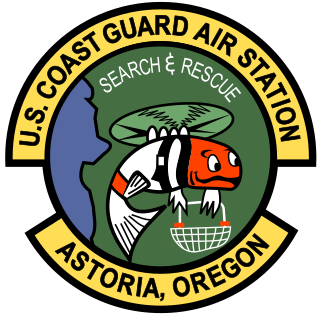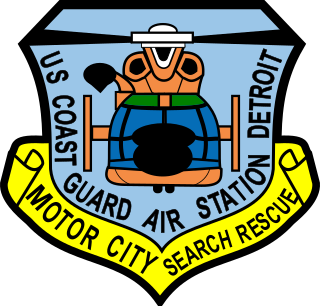
A coast guard or coastguard, is a maritime security organization of a particular country. The term implies widely different responsibilities in different countries, from being a heavily armed military force with customs and security duties to being a volunteer organization tasked with search and rescue functions and lacking any law enforcement powers. However, a typical coast guard's functions are distinct from typical functions of both the navy and a transportation police.

The Eurocopter HH-65 Dolphin is a twin-engine, single main rotor, medevac-capable search and rescue (SAR) helicopter operated by the United States Coast Guard (USCG). It is a variant of the French-built Eurocopter AS365 Dauphin.

The Lockheed HC-130 is an extended-range, search and rescue (SAR)/combat search and rescue (CSAR) version of the C-130 Hercules military transport aircraft, with two different versions operated by two separate services in the U.S. armed forces.
Responsibilities for traditional coast guard duties in Australia are distributed across various federal, state and community agencies. The de facto coast guard of Australia is the Maritime Border Command, a joint command of the Australian Defence Force and the Australian Border Force which works alongside the Australian Federal Police, the Australian Fisheries Management Authority, and the Australian Maritime Safety Authority. Each state and territory government have specific maritime safety agencies and police marine units. In addition, there are several private volunteer coast guard organisations which act as auxiliary search and rescue services and maritime safety educators with the largest organisations being the Royal Volunteer Coastal Patrol established in 1937, the Australian Volunteer Coast Guard established in 1961, and Marine Rescue New South Wales established in 2009.

The Island-class patrol boat is a class of cutters of the United States Coast Guard. 49 cutters of the class were built, of which 37 remain in commission. Their hull numbers are WPB-1301 through WPB-1349.

United States Coast Guard Air Station Clearwater is the United States Coast Guard's largest air station. It is located at the St. Petersburg-Clearwater International Airport in Clearwater, Florida and is home to nearly 700 USCG aviation and support personnel. As of July 2015, there are thirteen MH-60T Jayhawk helicopters, one HC-130H Hercules and four HC-130H7 Hercules aircraft assigned to CGAS Clearwater. Also on static display is USCG 1023, a restored Grumman HU-16 Albatross.

The Sassafras is a C-Class, 180 ft, seagoing buoy tender constructed for the USCG by Marine Iron & Shipbuilding Corp. of Duluth, Minnesota. The Sass was one of 39 tenders commissioned for duties that would include aids-to-navigation, ice breaking, search-and-rescue, fire fighting, law enforcement, providing fuel and potable water, and assistance to the National Oceanographic and Seismographic Survey.

United States Coast Guard Station New Haven is located at 120 Woodward Avenue, New Haven, Connecticut 06512. It belongs to the Long Island Sound sector of operations.

United States Coast Guard officer rank insignia describes an officer's pay-grade. Rank is displayed on collar devices, shoulder boards, and on the sleeves of dress uniforms.

Coast Guard Air Station Astoria was established August 14, 1964 at Astoria Regional Airport in Warrenton, Oregon.

USCGC Woodrush (WLB-407) was a buoy tender that performed general aids-to-navigation (ATON), search and rescue (SAR), and icebreaking duties for the United States Coast Guard (USCG) from 1944 to 2001 from home ports of Duluth, Minnesota and Sitka, Alaska. She responded from Duluth at full speed through a gale and high seas to the scene of the SS Edmund Fitzgerald sinking in 1975. In 1980, she took part in a rescue rated in the top 10 USCG rescues when she helped to save the passengers and crew of the cruise ship Prinsendam after it caught fire in position 57°38"N 140° 25"W then while being towed sank off Graham Island, British Columbia. She was one of the first vessels to respond to the Exxon Valdez oil spill in 1989. She was decommissioned on 2 March 2001 and sold to the Republic of Ghana to serve in the Ghana Navy.
USCGC Tupelo WAGL/WLB-303, was a Cactus (A) Class 180 foot buoy tender built by Zenith Dredge Company of Duluth, Minnesota. Her keel was laid 15 August 1942, launched 28 November 1942 and commissioned on 30 August 1943. She was built as a WAGL and redesignated a WLB in 1965.

The EADS HC-144 Ocean Sentry is a medium-range, twin-engined turboprop aircraft used by the United States Coast Guard in the search-and-rescue and maritime patrol missions. Based on the Airbus Military CN-235 it was procured as a "Medium Range Surveillance Aircraft." The HC-144 is supplied by Airbus Group, Inc formerly EADS North America and is built in Spain by Airbus Military.

Coast Guard Air Station Detroit is an Air Station of the United States Coast Guard located in Detroit, Michigan. The station was established in 1966 and is located on Selfridge Air National Guard base. Early aircraft consisted of three HH-52A Seaguard helicopters with an area of operations encompassing Lakes Ontario, Erie, St. Clair and southern Lake Huron. During the summer months they assume responsibility for the southeastern portion of Lake Michigan and operate from an Air Facility located in Muskegon, Michigan. Air Station Detroit conducts flights in support of domestic icebreaking operations, Marine Environmental Protection (MEP), and search and rescue missions. Most notably they responded to several rescue missions during Hurricane Katrina of 2005. Today they support 30 Coast Guard shore units, five cutters, as well as federal, state, local, and Canadian government agencies. Detroit aircrews handle over 200 rescues annually. Currently the air station houses five HH-65 Dolphin helicopters.
The history of the United States Coast Guard Auxiliary began in 1939. From its formation, the United States Coast Guard Auxiliary has been supporting the United States Coast Guard. The Auxiliary works within the Coast Guard in carrying out its noncombatant and non-law enforcement missions.















